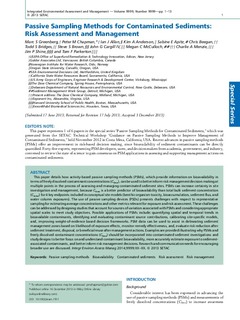| dc.contributor.author | Greenberg, M.S. | |
| dc.contributor.author | Chapman, P.M. | |
| dc.contributor.author | Allan, Ian | |
| dc.contributor.author | Anderson, K.A. | |
| dc.contributor.author | Apitz, S.E. | |
| dc.contributor.author | Beegan, C. | |
| dc.contributor.author | Bridges, T.S. | |
| dc.contributor.author | Brown, S.S. | |
| dc.contributor.author | Cargill, J.G. | |
| dc.contributor.author | McCulloch, M.C. | |
| dc.contributor.author | Menzie, CA | |
| dc.contributor.author | Shine, J.P. | |
| dc.contributor.author | Parkerton, T.F. | |
| dc.date.accessioned | 2014-02-27T11:20:19Z | |
| dc.date.accessioned | 2014-04-12T10:09:05Z | |
| dc.date.available | 2014-02-27T11:20:19Z | |
| dc.date.available | 2014-04-12T10:09:05Z | |
| dc.date.issued | 2013 | |
| dc.identifier.citation | Greenberg, M.S., Chapman, P.M., Allan, I.J.et al. 2014. Passive sampling methods for contaminated sediments: risk assessment and management. Integrated Environmental Assessment and Management 10(2) 224-236. | nb_NO |
| dc.identifier.issn | 1551-3793 | |
| dc.identifier.uri | http://hdl.handle.net/11250/194286 | |
| dc.description.abstract | This paper details how activity-based passive sampling methods (PSMs), which provide information on bioavailability in terms of freely dissolved contaminant concentrations (Cfree), can be used to better inform risk management decision making at multiple points in the process of assessing and managing contaminated sediment sites. PSMs can increase certainty in site investigation and management, because Cfree is a better predictor of bioavailability than total bulk sediment concentration (Ctotal) for 4 key endpoints included in conceptual site models (benthic organism toxicity, bioaccumulation, sediment flux, and water column exposures). The use of passive sampling devices (PSDs) presents challenges with respect to representative sampling for estimating average concentrations and other metrics relevant for exposure and risk assessment. These challenges can be addressed by designing studies that account for sources of variation associated with PSMs and considering appropriate spatial scales to meet study objectives. Possible applications of PSMs include: quantifying spatial and temporal trends in bioavailable contaminants, identifying and evaluating contaminant source contributions, calibrating site-specific models, and, improving weight-of-evidence based decision frameworks. PSM data can be used to assist in delineating sediment management zones based on likelihood of exposure effects, monitor remedy effectiveness, and, evaluate risk reduction after sediment treatment, disposal, or beneficial reuse after management actions. Examples are provided illustrating why PSMs and freely dissolved contaminant concentrations (Cfree) should be incorporated into contaminated sediment investigations and study designs to better focus on and understand contaminant bioavailability, more accurately estimate exposure to sediment-associated contaminants, and better inform risk management decisions. Research and communication needs for encouraging broader use are discussed. | nb_NO |
| dc.language.iso | eng | nb_NO |
| dc.publisher | Wiley - SETAC | nb_NO |
| dc.rights.uri | https://creativecommons.org/licenses/by/4.0/ | |
| dc.rights.uri | https://creativecommons.org/licenses/by/4.0/ | |
| dc.title | Passive sampling methods for contaminated sediments: risk assessment and management | nb_NO |
| dc.type | Journal article | nb_NO |
| dc.type | Peer reviewed | nb_NO |
| dc.date.updated | 2014-02-27T11:20:19Z | |
| dc.rights.holder | © 2014 The Authors under CC by lisence | |
| dc.source.pagenumber | 224-236 | nb_NO |
| dc.source.volume | 10 | nb_NO |
| dc.source.journal | Integrated Environmental Assessment and Management | nb_NO |
| dc.source.issue | 2 | nb_NO |
| dc.identifier.doi | https://doi.org/10.1002/ieam.1511 | |
| dc.identifier.cristin | 1098158 | |
| dc.rights.license | Attribution 4.0 International (CC BY 4.0) | |

